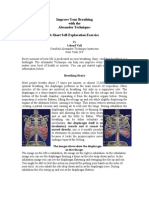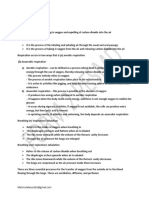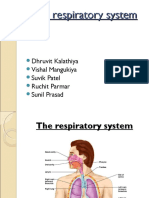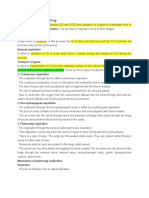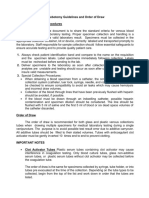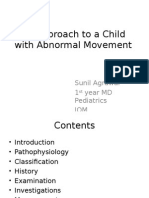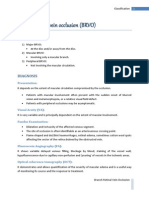Respiratory System
Respiratory System
Uploaded by
api-235944649Copyright:
Available Formats
Respiratory System
Respiratory System
Uploaded by
api-235944649Original Title
Copyright
Available Formats
Share this document
Did you find this document useful?
Is this content inappropriate?
Copyright:
Available Formats
Respiratory System
Respiratory System
Uploaded by
api-235944649Copyright:
Available Formats
http://www.youtube.com/watch?
v=p4z OXOM6wgE
Air enters through the nasal passage or mouth. Passes through the pharynx.
Opening in the back of the mouth
Larynx/ Adams Apple
Vocal folds-Allows vocal communication
Larynx contains
Glottis and epiglottis Protects during swallowing & allows air exchange
Larynx to Trachea Trachea enters the chest Trachea breaks into 2 major branches
Bronchus Leads to opposite sides of chest
Bronchi from smaller airways
Bronchioles
Bronchioles form into smaller opening
Alveoli Gas exchange
Alveoli
Gas Exchange Capillaries
Brings inhaled air to the circulating blood
Blood is delivered into the pulmonary circulation
Low in oxygen/high in carbon dioxide Gas exchanged with the alveoli
Hemoglobin absorbs the maximum amount of oxygen
Blood enters veins high in oxygen/ low in
carbon dioxide
2 step process: 1st step
Muscles between ribs contract and raise,
expanding the chest Diaphragm contracts Increasing the volume of air in the chest Lowering pressure within the lungs
During the process the lungs remain in close contact with the lining of the thorax
2nd step
Intercostal muscle relaxes Diaphragm relaxes and domes forward
towards the chest Elastic tissue drives out air Forces air outward
Around the room you will see various cards with pictures and vocab words on them.
You will.
Get up out of your seats Go get a card Read the word on the card Write something that you learned on the card With a partner a discuss what the card said and why it is important to the respiratory system
GO
Basic respiration rate changes due to what the body does.
Active=muscles producing more Carbon
Dioxide Special receptors detect the increase in CO2 in the blood Signals are sent to the brain Brain sends a message to increase respiration rate
Animal Respiration Rate
Animal
Cat Dog Sheep Cow Horse Human Guinea Pig Hamster
Respiration Rate (breaths per minute)
26 22 19 30 12 12 90 74
Why is this important?
Key points Air passes through the pharynx The Larynx is the opening to the major airways The epiglottis allows free exchange of air Air enters into the trachea which is an entrance to the chest. Bronchi branches from the trachea-entering into the lungs Bronchioles have smooth muscles on walls that open or close to protect the lungs
Key points continued
Alveoli are the smallest opening that allows
for gas exchange Capillaries surround the alveoli which brings air near circulating blood Blood delivered is low in oxygen and high in carbon dioxide-pulmonary circulation Blood entering is high in oxygen and low in carbon dioxide-pulmonary veins Hemoglobin absorbs oxygen 2 steps in breathing-chest expands increasing volume-chest contracts decreasing volume
You will have the opportunity to create a Road Map for the respiratory system. You may work in partners or individually.
You will be creating this travel guide for someone who has never been to the respiratory system.
Must include all parts of respiratory system May look like a brochure, map, or travel guide Can be creative and colorful
You might also like
- MOH 515 Updated 2022Document1 pageMOH 515 Updated 2022MARTIN100% (5)
- Improve Your Breathing With The Alexander TechniqueDocument3 pagesImprove Your Breathing With The Alexander TechniqueLeland Vall86% (14)
- A Pet Parent's Guide To The: Ketogenic DietDocument15 pagesA Pet Parent's Guide To The: Ketogenic DietTea Vincelj100% (1)
- Respiratory SystemDocument55 pagesRespiratory SystemRuwan WijesooriyaNo ratings yet
- Respiratory systemDocument4 pagesRespiratory systemcrystalamorssiNo ratings yet
- Gaseous Exchange PresentationDocument26 pagesGaseous Exchange PresentationRabbitNo ratings yet
- 09 Gas Exchange & RespirationDocument28 pages09 Gas Exchange & RespirationNADIANo ratings yet
- Anatomy of The Respiratory SystemDocument42 pagesAnatomy of The Respiratory Systempsidra456No ratings yet
- RespiratorychempowerpointDocument10 pagesRespiratorychempowerpointapi-252255196No ratings yet
- Breathing and Gas Exchange PowerpointDocument53 pagesBreathing and Gas Exchange Powerpointapi-263357086100% (1)
- Respiratory AnatomyDocument35 pagesRespiratory Anatomyapi-217919217No ratings yet
- The Respiratory SystemDocument5 pagesThe Respiratory SystemmvslikavNo ratings yet
- Respiratory System For PowelDocument41 pagesRespiratory System For PowelNikko Bondoc ManaloNo ratings yet
- The Respiratory System: Carolina Rancier Horacio Vicioso Patricia Otero Dessirée Reyes Ana CarolinaDocument8 pagesThe Respiratory System: Carolina Rancier Horacio Vicioso Patricia Otero Dessirée Reyes Ana CarolinapattsoteroNo ratings yet
- Life Process RespirationDocument48 pagesLife Process RespirationaramalakshmammaakulaNo ratings yet
- The Respiratory System StudentDocument36 pagesThe Respiratory System StudentNoralene FabroNo ratings yet
- Respiration 2Document22 pagesRespiration 2Dominic Napoleon AndohNo ratings yet
- Gr.7 biology Ch.5 -with answerDocument51 pagesGr.7 biology Ch.5 -with answerlaith.naqouri1No ratings yet
- 05 RespiratoryDocument38 pages05 Respiratoryglenn johnstonNo ratings yet
- Respiration Ppt (1)Document36 pagesRespiration Ppt (1)shockwaveryftNo ratings yet
- Resp NotesDocument6 pagesResp NotesGreg ColomboNo ratings yet
- Chapter 11 Bio NotesDocument4 pagesChapter 11 Bio NotesArabella ShepherdNo ratings yet
- Respiratory SystemDocument19 pagesRespiratory SystemMichael QuijanoNo ratings yet
- Form 2 Term 2 NotesDocument4 pagesForm 2 Term 2 NotesdzichavakwashammahNo ratings yet
- Respiration - Year 8 BiologyDocument5 pagesRespiration - Year 8 Biologyanita.kangggggggNo ratings yet
- Handout On GAS EXCHANGEDocument4 pagesHandout On GAS EXCHANGEEli Joshua EvangelistaNo ratings yet
- Respiratory System OkDocument36 pagesRespiratory System Okakselerasi10No ratings yet
- The Respiratory System: Aam Amarullah, M.PDDocument42 pagesThe Respiratory System: Aam Amarullah, M.PDUniversal DiscoveringNo ratings yet
- Respiration NotesDocument4 pagesRespiration NotesJana AldourNo ratings yet
- Respiratory System ApuntesDocument5 pagesRespiratory System Apuntespaola arangurenNo ratings yet
- Topic 10 - Respiratory System Chapter 18Document6 pagesTopic 10 - Respiratory System Chapter 18api-388956899No ratings yet
- The Respiratory SystemDocument74 pagesThe Respiratory SystemRaghu Nadh100% (1)
- download_12_309Document11 pagesdownload_12_309sonia shaliniNo ratings yet
- The Human Respiratory SystemDocument2 pagesThe Human Respiratory SystemWei Ling KuahNo ratings yet
- 9 RespirationDocument3 pages9 RespirationKavin ManimaranNo ratings yet
- Chapter 7 Respiration F4 Bio NotesDocument6 pagesChapter 7 Respiration F4 Bio NotesteddyenNo ratings yet
- Respirasi: Kuncoro Puguh SDocument79 pagesRespirasi: Kuncoro Puguh SErni AnggrianiNo ratings yet
- Breathing and Exchange of GasesDocument7 pagesBreathing and Exchange of Gasessnowy78624No ratings yet
- Respiratory SystemDocument22 pagesRespiratory Systemsebastianbinary2No ratings yet
- معدل8 Respiratory SystemDocument11 pagesمعدل8 Respiratory Systemyo20061226No ratings yet
- 2013 Oxygenation UpdatedDocument310 pages2013 Oxygenation UpdatedAngeline Dela CruzNo ratings yet
- Respiratory SystemDocument3 pagesRespiratory SystemjoimaciascorreaNo ratings yet
- The Respiratory SystemDocument77 pagesThe Respiratory SystemPridas GidNo ratings yet
- The Respiratory SystemDocument2 pagesThe Respiratory Systemkakai0.0No ratings yet
- Respiratory SystemDocument16 pagesRespiratory SystemteametafereNo ratings yet
- Respiratory SystemDocument9 pagesRespiratory Systemapi-311834149No ratings yet
- Respiratory SystemDocument12 pagesRespiratory SystemM. Farkhan HabibNo ratings yet
- Respiration NotesDocument39 pagesRespiration NotesadityapeddiNo ratings yet
- Respiratory SystempptDocument26 pagesRespiratory SystempptRinaliza BogsulenNo ratings yet
- Respiratory System of FrogDocument3 pagesRespiratory System of Frogaparajuli089No ratings yet
- DescriptionDocument2 pagesDescriptionGliane, Adrie Ann C.No ratings yet
- Respiratory SystemDocument44 pagesRespiratory SystemDell ONo ratings yet
- Functional Human Physiology: The Respiratory SystemDocument64 pagesFunctional Human Physiology: The Respiratory SystemnashqonashNo ratings yet
- CHAPTER 13: The Respiratory SystemDocument11 pagesCHAPTER 13: The Respiratory SystemAthena ChoiNo ratings yet
- The Human Respiratory SystemDocument19 pagesThe Human Respiratory SystemChelsea EdwardsNo ratings yet
- Respiratory System of Frog: External RespirationDocument3 pagesRespiratory System of Frog: External RespirationShaira CogollodoNo ratings yet
- Respiratory SystemDocument7 pagesRespiratory SystemxoxogeloNo ratings yet
- Airway-Ap of The Upper and Lower Airway PDFDocument4 pagesAirway-Ap of The Upper and Lower Airway PDFfaisal alharbiNo ratings yet
- Breathing and RespirationDocument30 pagesBreathing and Respirationhamzahazard527No ratings yet
- Chapter 11 Gas Exchange Notes 1 PDFDocument6 pagesChapter 11 Gas Exchange Notes 1 PDFKai TongNo ratings yet
- Final PresentaionDocument30 pagesFinal Presentaionthapelomatlou959No ratings yet
- Respiration ExcretionDocument26 pagesRespiration ExcretionScribd_is_GreatNo ratings yet
- 4 Food and Animal DiseasesDocument24 pages4 Food and Animal Diseasesapi-235944649No ratings yet
- 7 Pearson SquareDocument19 pages7 Pearson Squareapi-235944649No ratings yet
- 2 Reproductive Male HWDocument1 page2 Reproductive Male HWapi-235944649No ratings yet
- 5 Livestock Nutrition MineralsDocument31 pages5 Livestock Nutrition Mineralsapi-235944649No ratings yet
- 1 Reproductive Female HWDocument1 page1 Reproductive Female HWapi-235944649No ratings yet
- ExamDocument12 pagesExamapi-235944649No ratings yet
- 6 Detecting Heat in LivestockDocument13 pages6 Detecting Heat in Livestockapi-235944649No ratings yet
- Respiratory Road TripDocument7 pagesRespiratory Road Tripapi-235944649No ratings yet
- Jessica Milstein Teaching ResumeDocument2 pagesJessica Milstein Teaching Resumeapi-235944649No ratings yet
- Cebu Normal University College of Nursing: Monitoring Progress of LaborDocument15 pagesCebu Normal University College of Nursing: Monitoring Progress of LaborEdzell Edge100% (1)
- Hypersomnia CaseDocument4 pagesHypersomnia CaseSana AkbarNo ratings yet
- Inter Mod Paeds PDocument39 pagesInter Mod Paeds PFaateh ImranNo ratings yet
- RISK STRATIFICATION Effective Use of ACSM.8Document7 pagesRISK STRATIFICATION Effective Use of ACSM.8Doraisy SHNo ratings yet
- Lab Report #6 CIRCULATORY SYSTEMDocument4 pagesLab Report #6 CIRCULATORY SYSTEMJamaica M DanguecanNo ratings yet
- Obat Antijamur: Wening Sari, DR., M.KesDocument18 pagesObat Antijamur: Wening Sari, DR., M.KesdebbyelviraNo ratings yet
- Treatment and Rehabilitation of Fractures (Stanley Hoppenfeld)Document1 pageTreatment and Rehabilitation of Fractures (Stanley Hoppenfeld)小蓮花No ratings yet
- Maret 18 PDFDocument178 pagesMaret 18 PDFAnonymous vLgCd0U7No ratings yet
- IrbesartanDocument9 pagesIrbesartanalip desi suyono saputriNo ratings yet
- Isi BukuDocument183 pagesIsi BukuHayat Hamzah DawiNo ratings yet
- Coagulation Cascade (Hema)Document4 pagesCoagulation Cascade (Hema)MarjoNo ratings yet
- Cardiac ImagingDocument32 pagesCardiac ImagingRafid DragneelNo ratings yet
- Pyrexia of Unknown OriginDocument17 pagesPyrexia of Unknown OriginHaziq KamardinNo ratings yet
- Yisheng Biopharma Profile For CandidatesDocument9 pagesYisheng Biopharma Profile For CandidatesKeith SummerNo ratings yet
- Endo - Review QuestionsDocument9 pagesEndo - Review QuestionsKristine CastilloNo ratings yet
- Course in The WardDocument5 pagesCourse in The WardRenie SerranoNo ratings yet
- Phlebtomy Guidelines and Order of DrawDocument3 pagesPhlebtomy Guidelines and Order of Drawohemgee wowNo ratings yet
- X-Ray Technician SafetyDocument2 pagesX-Ray Technician SafetyBorislav VulićNo ratings yet
- Role of Community Pharmacist: BY: Md. Mynul Hasan Southeast UniversityDocument10 pagesRole of Community Pharmacist: BY: Md. Mynul Hasan Southeast UniversityFerdous MostofaNo ratings yet
- Early Grade Reading Assessment For Kindergarten FinalDocument6 pagesEarly Grade Reading Assessment For Kindergarten FinalKhulyn Castro AlvarezNo ratings yet
- Oncology Nursing Health AssessmentDocument2 pagesOncology Nursing Health AssessmentkisNo ratings yet
- Medical Auditing Q and ADocument2 pagesMedical Auditing Q and AApril ManjaresNo ratings yet
- An Approach To A Child With Abnormal Movement: Sunil Agrawal 1 Year MD Pediatrics IOMDocument57 pagesAn Approach To A Child With Abnormal Movement: Sunil Agrawal 1 Year MD Pediatrics IOMJoyee BasuNo ratings yet
- Athletic InjuriesDocument5 pagesAthletic InjuriesAdaamShabbirNo ratings yet
- Blood Bank TrainingDocument82 pagesBlood Bank TrainingMohamed Elmasry0% (1)
- PASSMED MRCP MCQs-RESPIRATORY MEDICINE PDF PDFDocument6 pagesPASSMED MRCP MCQs-RESPIRATORY MEDICINE PDF PDFهادي تركي شنبارةNo ratings yet
- Branch Retinal Vein Occlusion (BRVO)Document4 pagesBranch Retinal Vein Occlusion (BRVO)Mahmoud Ahmed MahmoudNo ratings yet

